
It’s lunchtime, your stomach is growling and you’ve decided to make a sandwich. But as soon as you head to the pantry and open the bread bag, you see it: a whitish, greenish spot. Ugh — it’s mould.
Some slices look OK, though, with smaller or no mouldy bits. Are those safe to eat? Maybe they haven’t been touched by the mould yet, you think.
Advertisement
The idea of eating them is gross, but if you are super hungry or haven’t been to the grocery store lately, you may be low on other options.
Plus, with the expectation that food costs will rise under President Donald Trump’s administration and the desire to reduce food waste, who wants to toss a whole loaf? Some might wonder if certain slices are still fine to eat, or at least won’t cause major stomach problems. Let’s see what food experts say.
What To Do If You See Mould On Just 1 Slice Of Bread
Unfortunately, mould on one slice is essentially mould on every slice (which is also the case for produce, by the way). It doesn’t matter if one piece looks fine or isn’t touching the mouldy area — it’s all dangerous to eat.
Advertisement
“No matter how little the mould spot is on the bread, or how many slices are left of the loaf, it is not safe to eat mouldy bread nor just cut around it and eat the rest, because the root of the mould already has deeply penetrated into it,” said Shelley Balls, a registered dietitian nutritionist with ServSafe manager certification on food safety.
And just because you might not see mould doesn’t mean it’s not there. “You may only see visible mould growing on the surface, like leaves on a tree or the petals of a flower,” explained Leanne Blommaert, the manager of food research and development at NSF, a public health organisation. “But there is an entire network of roots called mycelia that can spread into and across all surfaces of bread.”
Besides being gross, this can make you feel sick.
The Dangers Of Eating Mould
If you’re a fan of blue cheese, you may think it’s perfectly fine to eat some mould. You’ve done it before and been OK, right?
Advertisement
That’s understandable and, in some cases, true. Mould isn’t always bad — but it can be.
“Eating mouldy bread can upset your digestive system or cause allergic reactions, depending on the type of mould,” said Chris Mohr, a fitness and nutrition adviser at the website Garage Gym Reviews.
Dr. Kelly Krisna Johnson-Arbor, a medical toxicologist with the MedStar Health hospital system, explained how this can happen. “Some types of mould that are found in spoiled bread, including Aspergillus and Penicillium, are also associated with allergies that can occur immediately or hours after people come into contact with them,” she said.
She added that gastrointestinal symptoms — like abdominal pain and diarrhoea — may come from mycotoxins, which are secondary compounds from mould. They can change normal intestinal functions, with unpleasant results.
Advertisement
Those aren’t the only issues you may face, unfortunately. Even breathing in mould can cause health problems, according to Balls. People with asthma are especially at risk, Johnson-Arbor added, as the allergens can trigger breathing difficulties.
Johnson-Arbor recommended playing it safe. “Since some types of mold can cause unwanted health problems, and since it’s impossible for most people to tell whether a specific mould is harmful or not based on its appearance on food, it’s best to avoid consuming most mouldy foods,” she said.
If you want a cheat sheet on when mould may be safe to eat (or eat around), check out this webpage from the U.S. Department of Agriculture.
Advertisement
Why Some Bread Slices Get Mouldy Faster Than Others
Even when bread slices sit together, some can mould faster than others. How?
Balls said slices that mould faster may have more moisture or be warmer. She gave the example of a bread loaf with one side closer to a toaster, thus making it warmer and more likely to grow mould first.
Touching bread — with your hands or utensils — can cause mould spores to grow, too, Blommaert added. And that mould can spread.
Plus, mould can be airborne. Mohr said that slices near the seam of a bread bag, or near the end of a loaf, may mould faster. That’s because they’re closer to the air and moisture in your kitchen. Even if you don’t leave the bag open, it’s exposed to more air when you open it.
Advertisement
How To Prevent Mould From Growing On Your Bread
To some degree, mould growth is unavoidable with certain foods. However, there’s a way to slow its progress.
“You can safely store your bread in the fridge to extend its shelf life without any dangerous health risks,” Balls said.
The bread may become harder, she noted, but it’s safe to eat.
Whether this is the best option depends a little on the type of bread, however. Balls said to store crusty types of bread at room temperature only, but commercially made bread will have no or minimal problems with texture or flavour after sitting in the fridge. Just place it in an airtight container to prevent it from drying out.
Advertisement
Putting bread in the freezer can also keep it from drying out, and it could still taste about the same as when you first bought or baked it. If you have more than you can eat in a few days, your slices may best reside there.
Additionally, Blommaert suggested checking the expiration date of your bread and not consuming it past then. According to the USDA, commercially baked breads can be stored at room temperature for two to four days, refrigerated for seven to 14 days, or frozen for three months.
For anyone wanting to eat bread safely, Mohr offered this simple advice: “When in doubt, throw it out.”
Advertisement




 یاشار (@yashar)
یاشار (@yashar)  (@renegadeapostle)
(@renegadeapostle) 
